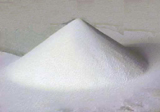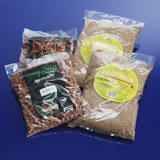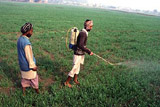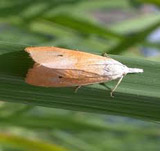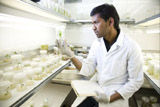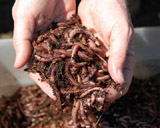Farming and health
Photobionics — experiments and results
Abstract
Photobionics is the science which explores the practical applicability of the spiritual truth that all creation is the condensation of cosmic light of varying frequencies. A few chemicals were intuitively identified to be the triggering ingredients of certain biological processes of plants (and all other living beings). When these chemicals were sprayed over plants in micro-dilutions, there remained no necessity for using chemical manures or pesticides. The series of trials that were undertaken and the results that varied according to season, soil and other conditions are given here below.
Introduction
Photobionics is a science which explores practical implications of the spiritual truth that all creation is the condensation of cosmic light which operates through Nature in various rhythms(1). The possibility of extending the knowledge of kuṇdalinī and cakras to all living and non-living things, therefore, also becomes its field of exploration.
When seen in this perspective, micro-dilutions of certain chemicals when sprayed upon plants are found to enhance plant growth and resistant capacity. The use of artificial fertilizers and pesticides can thus be completely avoided. The ultimate aim is to achieve the yield of nature‘s optimum without artificial fertilizers, thereby obtaining the innate balance of various carbohydrates, proteins, terpenoids and flavonoids in the farm produce.
It is known that plants synthesise their food through photosynthesis. The light reaction (harvesting of cosmic rays from the sun and other planets) , dark reaction (producing various carbon compounds utilising the electrochemical energy generated through light reaction) and transpiration (losing water through stomata, thereby creating a levitative effect on the photosynthetic substrates and coolant and catalytic effect on the biological mechanisms) are seen to carry themselves in cycles which match with the five chief movements of praanic force — prāṇa, apāna, vyāna, samāna and udāna. Thus an intuitive contact with the inner movements of plants is made possible. Again these biological reactions are found to have a tissue specificity of root, stem, stem tubules, leaves and the photosynthetic apparatus which can be considered as mulādhāra, maṇipura, viśuddha, ājña and sahasrāra cakras respectively. Based on this knowledge, specific chemicals which stimulate the activity of these tissues are recognised and used. This, in brief, is how photobionics is applied on plants.
The need
As photobionics is a spiritual science, the continuity that exists between the higher realms and the material results has to be thoroughly seen in practice and this needed a different outlook at each problem we had to address. Seen from a spiritual perspective, even the competitors and enemies become a part of the whole and must be relegated to appropriate positions according to their cause of existence in the play of life. As the spiral of life ascends to higher realms, the cycles that build the spiral become conjoined or disjointed at various phases of time and the ultimate outcome is rich in completeness only when due respect is given to this hierarchy.
Some of the interesting features that we had to take into consideration are here.
1. We tried to see pest infestation or any other disease as an evolutionary crisis either in the soil health or atmosphere around to sustain the plant life, the evolution of inconscient into conscient. So our efforts were limited to repelling the pest but not killing it.
2. The phenomenon of cloud formation or rains is directly related to the greenery around. The artificial cloud-seeding of the sky involves spraying heavy metals like silver iodide into the sky which attracts the clouds around into the rain-drought regions. If we assume that Nature also follows the same principle of bringing clouds together where there is a high concentration of heavy metals, then we may attribute the untimely rains and cyclones to the heavy usage of pesticides which contain heavy metals as their ingredients. That these untimely rains are a blessing in disguise as they wash away the heavy dose of pesticides sticking to the plants or at least dilute them is a matter of deep environmental interest.
3. Though achieving a yield equivalent to artificial methods is one of our aims, we did not consider this as the prime motive and concentrated on the wholesomeness of the produce and standardisation of the formula as the targets to be achieved first. That the best quality yield need not weigh in proportion to the artificially grown yield has become our conclusion as we proceeded in our experiments.
4. Prayer, the effective means of opening oneself to higher realms and becoming a bridge between the higher and lower, is always attended with every effort we put in this organic farming. As this process involves unleashing latent energies of Nature, respectfully dealing with things is inevitable and is rewarding in terms of knowledge and prosperity.
The trials
To conduct experiments on the theory of Photobionics, we did not follow a pro-forma of rules and measures but tested the formula of medicines on a random basis. That is, we availed every opportunity to test our formula and tried to prove its efficacy to each farmer who showed an interest in our work. After we had found some initial success to our satisfaction, we gradually fixed some aspects of the experiment so as to standardise the result. But in all our experiments, we took utmost care to see that even the water flows straight into our experimental plot from the canal and not from the adjacent plots in which artificial manures are used.
Process of using photobionic medicines
To start with, the seeds are to be soaked in a series of potentised medicines with a gap of one hour in between to allow the enzymes produced to increase in concentration in the meantime. Usually we start the process of soaking the seeds in the morning around 6-7 am so that the soaking in successive medicines falls into tune with the appropriate time in which a biochemical reaction is initiated in the seed based on the photosynthesis. This is the order we follow.
1. Urea 32c for 12 hrs to break the outer coat (cuticle) - promotes the root system
2. Kali carb 32c for 4hrs to promote stem formation (promoting the absorption of water into the primordial cell thereby the formation of different solutes of minerals)
3. Alumina 32c for 2-3 hrs to stabilise minerals absorbed in the form of ligands.
4. Magnesium sulph 32c for 2hrs to activate all other enzyme processes (companion cell formation which keeps the contact between the photosynthetic electron chain and organic solute production in the phloem)
5. Cuprum sulph 32c, Zinc sulph 32c, and Sulphur 32c independently potentised in distilled water and mixed together, for 1-2 hours to activate all mineral based enzymes related to photosynthesis (to bring into contact the enzymes of photosynthesis with the minerals absorbed into the xylem vessels)
Once this priming of seeds is done, the seeds are sprinkled in the fields.
6. As the plant grows, we discovered by trial that micro-nutrients necessary for plant growth should be sprayed in potentised form to promote healthy growth and prevent pests from flourishing due to the unnatural proteins growing in the plants. So, a routine method of spraying Urea 32c, Kali carb 32c once in 1-2 weeks was done in the first month. After transplantation, Urea 32c, Kali carb 32c, Ammonia 32c were serially sprayed once in 1-2 weeks till the end of the crop. Any additional requirement of medicine depended on the situation therein.
All the trials were done with the seeds treated as above.
1st trial
The first trial was done in plastic trays. In the 1st tray photobionic seeds in normal soil were used. In the 2nd tray artificial manures were added to the normal seeds. In the 3rd, normal seeds were put in the soil without any additives. The sprouts in the 3rd tray soon perished. A parallel growth was observed in the other two trays. Encouraged by this, we started experiments in the field.
2nd trial (Jan ‘11 — April ‘11)
We starteded the 2nd trial in a 30 cent field. The field was cultivated with seeds treated by the method given above. The plant growth was slow and the plants did not develop as many tillers (offshoots) as the plants in neighbouring fields. By the end of the trial, we noticed that the panicle eruption was getting delayed. Sensing a problem we sprayed Urea 32c and to our surprise, panicles started erupting within 24 hours. The process was complete within 3-4 days. However a stem borer infestation started by the end of maturing crop and we lost up to 20-30% of the crop.
3rd trial ( June ‘11 — Dec ‘11)
Area: 3 different pieces of land of about 30-50 cents
We started the 3rd trial with seeds treated as mentioned above in 3 different pieces of land (belonging to 3 different farmers) measuring 30-50 cents. This time we sprayed Urea 32c and Kali carb 32c once every 15 days till the plants grew to their optimum size. We then sprayed Urea and Magnesium sulph in 32c potencies in the last phases of panicle eruption. This time there was no delay in the growth of plants as compared to the neighbouring fields. Also the panicle eruption was prompt. The stem borer disease was controlled. The number of tillers (offshoots) was less and so there was a relative yield drop. In one of the plots where the soil fertility was poor (this soil was notorious for poor yield in the previous seasons), the farmer noticed a heavy insect infestation (BPH — brown plant hopper) and was worried. He insisted that we do something immediately to save the crop. We sprayed neem oil in a high concentration to control the infestation. The other two plots were healthy without any infestation but we still sprayed neem oil as a preventive measure as the pest might catch up here also (since neighbouring fields were regularly spraying pesticides). The ultimate outcome was highly satisfactory. The farmers around witnessed our experiment and were full of admiration but were sceptical about its repeatability.
Observations: The number of tillers was less. The stem borer infestation was under control.
4th trial (Jan ‘12 — April ‘12)
Area: 3 different plots of 30-50 cents.
We started the 4th trial in the same three plots. The trial went on smoothly and we followed the same formula of spraying Urea, Kali carb in 32c. We used Ammonium causticum in 32 c also to see if the hydroxide of Ammonia has an advantage over Ammonia in transporting the solutes from root to shoot. We could not reach a clear conclusion from this as we did not have a scientific team to assess the biochemical changes at tissue level. On the whole, the trial in this season was uneventful as in Rabi season every farmer expects a good crop with good yield owing to the favourable climate.
The chief observations during this trial are as follows:
1. In one of the plots where soil fertility was low, the plant growth was disappointingly poor and even the leaves and stems did not grow to the optimum. We were prepared to lose all yield and as a last resort tried a medicine — Methyl salicylate 6c — which sends hormonal signals to nearby plants regarding growth and protection. The medicine acted miraculously and we could gain a 50% yield.
2. The pest-resistant capacity of the photobionically grown plants was very good. The farmers did not notice any pests during the whole course although the farmers in the adjacent plots sprayed pesticides 4 to 6 times on various occasions. The stem borer was much under control though it was rarely seen here and there.
5th trial (June ‘12 — Dec ‘12),
Area: 7 acres
This time we tried to experiment in a single large area of land of 7acres (1 acre is 100 cents).There was an initial stunting of growth in the seed beds and so transplantation of the crop had to be postponed by 7-10 days. Even plucking of the plants from the seed bed became difficult and on an average more labourers were needed as the root growth was more than the stem growth. The plants recovered well after transplantation and their growth was almost on a par with the adjacent 2 acres plot farmed in the regular way with pesticides and fertilizers. Yet the number of tillers was less and so it became clear that we were going to get less yield.
Suddenly there was a heavy pest infestation (BPH — brown plant hopper) and all the farmers took to spraying pesticides. The pest started a bit late in our field but then it caught up and other farmers warned of total loss of the crop unless we intervened. We sprayed neem oil only and waited to see what would happen. The pest receded in due course of time and the degree of loss in our field was less as compared to other fields sprayed with pesticides. Within a week of this, a cyclone (Neelam) washed out all the crops in our area. The fields were flooded with water for weeks. The crop grown with photobionic treatment could sustain this. (This could be due the type of the seed. We chose BPT 5204, and the other farmers who suffered complete loss had chosen ‘swarna‘, a seed variety notorious for its poor strength of stem.)
We achieved 11 bags/acre. Bad weather conditions with 2 spells of heavy rains and heavy pest infestation which lasted more than 20 days were the chief cause. Most of the farmers around us could not procure any yield because of the cyclone.
Observations: Number of tillers was less. The plants could sustain the water logged condition for more than 1week whereas the plants in other fields could not.
Deliberations with agricultural scientists
I consulted some scientists at an agricultural university and explained our experiments to them. The agricultural department denied any possibility of sustained yield without fertilizers. The optimum presence of fertilizers especially nitrogen, phosphorus and potassium present in the soil is the chief determinant of the yield or output. According to them, if these minerals are not restored in the soil by artificial means, one can get satisfactory results in the first few crops but gradually a yield drop occurs as these minerals get depleted.
If this was correct, we would get a still lesser or almost the same yield in this crop by the end of the season if we sowed the same field without fertilizers.
On enquiring about any tests to verify the quality of rice, I was informed that they did not have that facility. Such tests would have to be devised in order to study the quality of rice and its organic nature. We have started exploring the possibility of creating simple, cost-effective test methods.
6th trial (Jan ‘13 — April ‘13)
Area: 7 acres
We continued our experiment on the same plot. The stunting of growth was present but less conspicuous. The time delay of 7-10 days for transplantation also took place. All other processes went on as usual. The climate was very friendly all through and all the farmers got very good yields. There was an increase in the yield when compared to the earlier crop. to 18 bags/acre. Other farmers got 40 bags/acre. The stem borer infestation that happened in this crop could be controlled. The other farmers got 40 bags/acre.
Observations
Stem borer infestation is almost under control. New methods to control pest infestation can be tried. Lab tests proved that antioxidant activity of photobionic rice is 5 times more when compared to artificially grown rice.
Discussion
We intentionally ignored the issue of soil enrichment in order to rely upon the efficacy of photobionic potencies alone. As a normal practice, organic farmers put all their efforts to improve soil fertility by incorporating vermicompost, animal dung, bacterial cultures (bio-fertilizers, as they are called) and growing leguminous plants etc. They also sprinkle vermicompost instead of chemical fertilizers throughout the crop period to boost the plant growth. But in our method, whatever we are doing through photobionic potencies helps only in maintaining healthy growth of plants.
Now when these two methods — improving soil fertility and maintaining plant health are applied together, the yield has to naturally improve further. This is the aim we have put before us for the next crop.
With the help of the Pharmacy Department of Dr. B.V. Raju College at Bhimavaram, we started devising tests to assess the quality of rice. A comparative study of the antioxidant activity of photobionic rice versus artificially grown rice was undertaken by spectroscopically studying the ethanolic extracts of both the samples. Photobionic rice was proved to have 5 times more antioxidant activity than the artificially grown rice (2).
7th trial (June ‘13 — Dec ‘13)
Area: 7 acres
We sprayed about 1 tonne of vermicompost in the 7 acre area after ‘wet-peddling‘ (that is filling the soil after repeated watering) the soil before sowing the plants. This brought a great change to the health of the plant even during seed-bed stage. We noticed that there was no stunting of growth this time.
After 10 days of transplantation, we sprayed Urea 32c. We sprinkled another tonne of vermicompost within a week after that. After another week, we sprayed neem oil as a preventive measure to fight pests. Then we sprayed Kali carb 32c after a gap of 2 weeks.
The number of tillers increased to 12-15 per each plant. The farmer noticed the presence of pest (BPH — brown plant hopper) but was not alarmed as they were not spreading fast. This infestation lasted for more than a month and the pest started to reappear even though it got washed away with each rain (there were frequent rains as it was rainy season). As other farmers started spraying pesticides, we too sprayed neem oil followed by Methyl salicylate 6c. There was considerable reduction in pests each time we sprayed the potentised medicines. Finally, the cyclone Phailin struck. The continuous downpour of rain of about 1week washed away all the pest infestation and the paddy plants which had turned brown started turning green once again. But there was enough damage already and we sprayed another round of Kali carb 32c and Methyl salicylate 6c.
We achieved a yield of 16 bags/acre in this season (which is normally low-yielding for rice), which was only 2 bags less than the last time. Other farmers got 25 bags/acre which was 15 bags per acre less.
Observations
Soil enrichment eased the growth of plants further and led to increased number of tillers. New methods to control pest infestation have to be found out. Relative increase in yield is noticed.
Discussion
Organic farming by Photobionics is cost-effective as the potentised remedies cost almost nothing. The quality of the yield has to be further studied by various methods. There is a possibility that the photobionically grown seeds may be more rich in vitamins and other nutrients depending upon the climate, soil and time of administration of medicines. Also some certification and quality check will be available to prevent duplicate and spurious products in the market. This needs collaboration with highly equipped labs.
Photobionics may be applied to all other crops and flowering plants on the same basis but with varying formulae. Such a possibility is testified by these paddy trials. Inspired by this, we started experiments on tomato, brinjal and capsicum last month. With these efforts from our side, we go ahead in time to see what sweet lessons Mother Nature has in store for us as we try to follow in her footsteps. A happy journey indeed.
References
1. Palla V. Photobionics — an innovative application of the law of similars. NAMAH 2013; 21(3):p. 9-17.
2. Sagi AK. A comparitive evaluation of the antioxidant potential of organic rice and a commercial variety. NAMAH 2013; 21(3):p. 18-20.
Dr. Venkatesh Palla, a member of SAIIIHR, is a practising homoeopathic physician at Bhimavaram, Andhra Pradesh, India.
Share with us (Comments, contributions, opinions)
When reproducing this feature, please credit NAMAH, and give the byline. Please send us cuttings.




